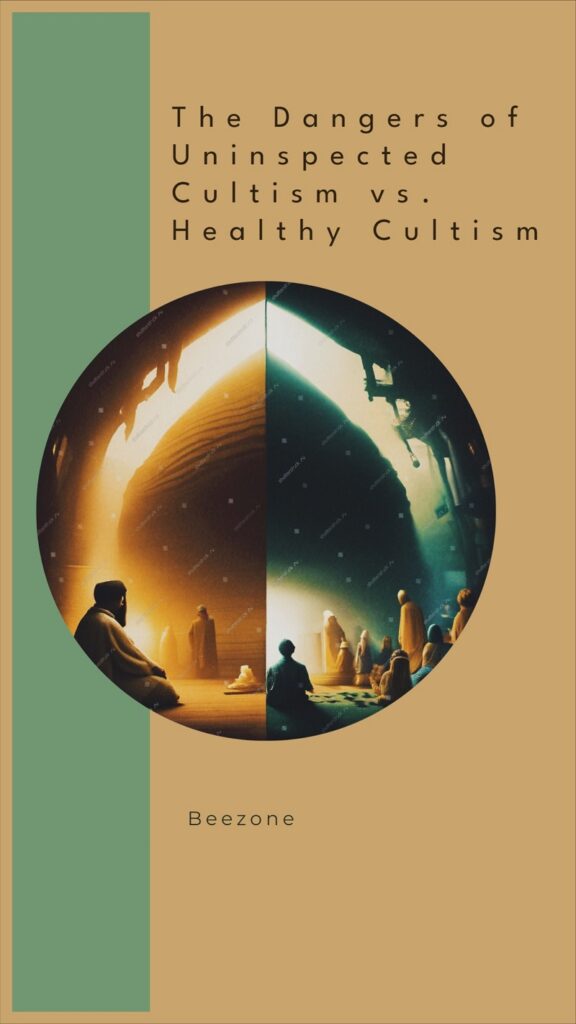
Cultism often conjures images of mind-controlling organizations led by charismatic figures, drawing individuals into their orbit with promises of enlightenment or salvation. The term carries a predominantly negative connotation, primarily due to the psychological scars left on those who blindly follow such leaders. However, the concept of cultism is not inherently detrimental; there exists a category of “healthy cultism”—groups that unite around positive missions, fostering a sense of community and shared purpose. This essay explores the dangers of uninspected cultism while affirming the value of healthy cults, emphasizing the importance of individual growth and critical self-examination.
The Dark Side of Uninspected Cultism
Uninspected cultism thrives on a dangerous, uncritical devotion to charismatic leaders fostered primarily by the group themselves, leaders within the “fold.” This kind of “grouping” is governed mainly by peer pressure and a system of language manipulation, most of which is unspoken and uninspected. Leaders, more than the Leaders themselves, often exploit their fellow traveler’s vulnerabilities, promoting an identity that prioritizes group allegiance over individual authenticity. The resulting environment can become toxic, where dissent is quashed and questioning is seen as a betrayal. This kind of cultism can leave deep psychological scars not only on current members but also on those who have distanced themselves from such groups.
The error of conventional cultism lies in its childish and adolescent orientation. Many individuals find themselves captivated by the allure of spiritual masters, projecting their hopes and insecurities onto these figures. This dynamic fosters a culture where ego-based identities flourish, leading to an unhealthy dependency on external validation and guidance. Followers become trapped in a cycle of adoration, often sacrificing their individuality for the perceived safety and belonging that group identity provides.
The Role of Healthy Cultism
In contrast, healthy cults can offer significant benefits. These groups gather individuals around a shared vision, whether religious or secular, creating a vibrant community united by positive values. Healthy cultism promotes personal growth, encourages diversity of thought, and fosters a supportive environment where members can thrive both collectively and individually. Such groups emphasize a balanced interplay between group identity and personal authenticity, allowing members to contribute to the mission while remaining true to themselves.
However, even within healthy cults, the potential for negative dynamics to emerge remains. When members cling too tightly to group identity, the risk of devolving into uninspected cultism increases. This tendency often stems from an unresolved desire for belonging that can manifest as a regression to childish dependence on the group. It is essential for members of any group—especially those with a spiritual dimension—to remain vigilant against this tendency.
The Necessity of Critical Self-Examination
To combat the dangers of uninspected cultism, both within traditional religious structures and secular movements, a rigorous process of self-examination is required. This involves critically assessing not only the group’s mission but also one’s motivations for participating. Are you seeking genuine community and support, or are you inadvertently surrendering your individuality in exchange for a sense of belonging?
The error of religious and spiritual cultism—and the ego-based culture that often accompanies it—must be examined with urgency and seriousness. Rooting out these errors requires individuals to confront their own psychological needs and motivations, fostering a culture of critical inquiry within the group. Members must cultivate an awareness of their inner lives, recognizing the difference between healthy connection and unhealthy dependency.
Conclusion
Cultism, as a phenomenon, exists on a spectrum that spans from the dangerously uninspected to the vibrantly healthy. While the allure of belonging to a group can be powerful, it is crucial to differentiate between the two extremes. Uninspected cultism, marked by a childish fixation on leaders and group identity, can inflict lasting damage on individuals and communities. Conversely, healthy cults can nurture growth and foster a sense of purpose when grounded in individual authenticity and critical engagement.
To create and sustain healthy communities, we must collectively strive to root out the unexamined tendencies that lead to the pitfalls of cultism. This requires a commitment to introspection, honesty, and the courage to question both ourselves and the groups we associate with. Only through this diligent self-examination can we build a future where cultism becomes a source of empowerment rather than a breeding ground for dependency, isolation, and despair.